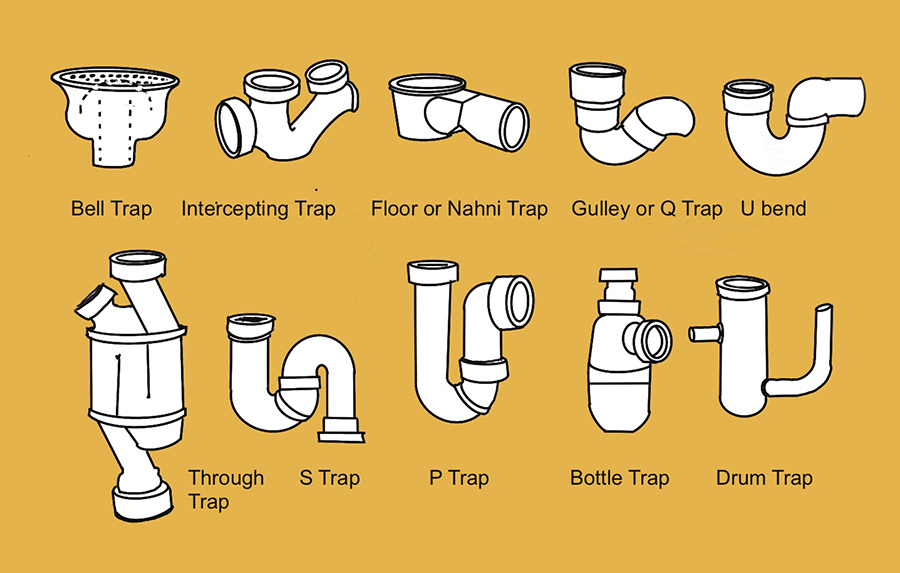Types of waste trap
Contents |
[edit] What are waste traps?
Waste traps or traps are small plumbing devices designed to prevent odours from sewage or waste water leaving the pipe systems and entering the interior spaces of buildings. They can also help prevent the spread of bacteria and insects.
They are simple but ingenious devices that generally work by creating an air trap using the waste water of the system, which sits in a small reservoir within in the line of the waste water flow. It is normally a relatively simple plumbing part used in sinks, toilets, showers, baths as well as floor level drains, coming in a variety of types with various terms associated.
[edit] Types of waste trap
Some of the more common types of waste trap are described below.
[edit] U-bend
The U-bend is possibly the most common term used to describe a waste trap in the UK. The variations on this type all contain a U shaped form in their design. The U trap was invented by the English businessman plumber T.Crapper in the late 1800's and was an improvement on the S trap which was invented some 100 years earlier.
[edit] S trap
The S trap was invented by A.Cumming who also patented the first flush toilet, it developed into the U-bend, which was an improvement because it did not need an overflow pipe.
Shallow or low-level U-traps are based on the same system as the U-bend, but are shallow so that they fit into tight spaces such as underneath showers and bath units.
[edit] Gully or Q trap
A gully trap or Q trap has a basin in the ground with a water seal for odours and a vent pipe to allow fresh air in.
[edit] Floor or nahni trap
A floor or nahni trap is a shallow design of minimum 50 mm depth provided in the floor to drain and prevent smells entering internal spaces. Nahni is indian for washing area, where these are commonly used.
[edit] Interceptor trap
Interceptor traps normally act between the main sewer and building sewer, they have deep water seals of 100 mm to prevent bugs and insects crossing systems and are usually found in the outlet of the last manhole chamber from a property before the main sewer connection and are typically made of vitreous clay. There are many different types such as: The Winser trap, Kenon trap, Bristol trap, Buchan trap, Reverse Interceptor trap, The Radnor, The Netley (reverse action), The Warwick, The Coulsdon and The Salus.
[edit] Bell trap
A bell trap contains a water reservoir cup which has a bell shaped cover over it that dips at the edges into the water filled cup to form a seal.
[edit] Straight-through trap
A straight-through trap or through trap is a compact trap specifically allowing for neat plumbing behind basin pedestals.
[edit] P-trap
A P-trap is a u-shaped bend in a waste pipe,containing sitting water, that connects a sink's drain to a septic tank or main sewer system.
[edit] Bottle trap
A bottle trap is attached under a sink to block gases from rising from a drainage systems into a bathroom.
[edit] Drum trap
Drum traps are often found in older systems functioning in a similar way to bottle traps.
[edit] Other type or names for traps
Grease trap, running trap, low-level bath trap etc..
[edit] Related articles on Designing Buildings
Featured articles and news
RTPI leader to become new CIOB Chief Executive Officer
Dr Victoria Hills MRTPI, FICE to take over after Caroline Gumble’s departure.
Social and affordable housing, a long term plan for delivery
The “Delivering a Decade of Renewal for Social and Affordable Housing” strategy sets out future path.
A change to adoptive architecture
Effects of global weather warming on architectural detailing, material choice and human interaction.
The proposed publicly owned and backed subsidiary of Homes England, to facilitate new homes.
How big is the problem and what can we do to mitigate the effects?
Overheating guidance and tools for building designers
A number of cool guides to help with the heat.
The UK's Modern Industrial Strategy: A 10 year plan
Previous consultation criticism, current key elements and general support with some persisting reservations.
Building Safety Regulator reforms
New roles, new staff and a new fast track service pave the way for a single construction regulator.
Architectural Technologist CPDs and Communications
CIAT CPD… and how you can do it!
Cooling centres and cool spaces
Managing extreme heat in cities by directing the public to places for heat stress relief and water sources.
Winter gardens: A brief history and warm variations
Extending the season with glass in different forms and terms.
Restoring Great Yarmouth's Winter Gardens
Transforming one of the least sustainable constructions imaginable.
Construction Skills Mission Board launch sector drive
Newly formed government and industry collaboration set strategy for recruiting an additional 100,000 construction workers a year.
New Architects Code comes into effect in September 2025
ARB Architects Code of Conduct and Practice available with ongoing consultation regarding guidance.
Welsh Skills Body (Medr) launches ambitious plan
The new skills body brings together funding and regulation of tertiary education and research for the devolved nation.
Paul Gandy FCIOB announced as next CIOB President
Former Tilbury Douglas CEO takes helm.
UK Infrastructure: A 10 Year Strategy. In brief with reactions
With the National Infrastructure and Service Transformation Authority (NISTA).























